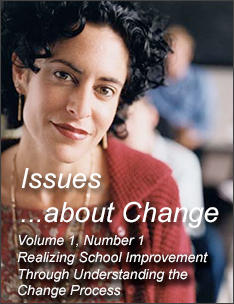Realizing School Improvement Through Understanding the Change Process
Introduction
Federal legislation, state regulations, district mandates - in addition to local school and community interests - all have demanded change, improvement, and new results from schools. These voices have vigorously exhorted school administrators and teachers to respond to the challenges of producing a more technologically prepared citizenry and to the needs of various student populations designated as at-risk. While schools have responded with effective schools projects, school improvement programs, and any number of efforts to change curriculum and instructional practices, little real or widespread change seems to have occurred. Schools, classroom settings, teaching, and instructional strategies are remarkably the same as they were years ago (Brandt, 1991). Cuban (1988, p. 89) observes that "innovation after innovation has been introduced into school after school . . . disappearing without a fingerprint." Why has so little change been realized? Why have so few new results been obtained?
Nearly everyone is familiar with the number of highly promising new programs or innovations that have paraded through schools. Their recurring introductions were matched all too frequently by teachers' antipathy and resignation. "Don't put too much energy into this one," they would say, "this, too, will go away." This is not to fault teachers, who typically received little support, guidance, or assistance in implementing the new programs. Rather, the change process was not given sufficient attention.
The regular demise of this multiplicity of programs led to the judgment that the innovations themselves were not effective, because they produced no appreciable student outcomes. In most cases, in fact, the programs were never incorporated into the day to day operations of classrooms and could be found in bookshelves gathering dust. As Fullan (1982, p. 22) suggests, "Reforms . . . may fail to make a difference . . . because the plans and resources necessary to accomplish implementation are not adequate to the task." A simple way to state this lack of events is: no implementation, no change, no improved results.
The good news is that we understand a great deal about the process of change and how to incorporate new programs into classroom life. Acting on that understanding can provide a significant means for moving schools toward desired improvement. One of the imperatives for acting immediately to address school change and improvement is the status of many children in our society, and their widespread lack of success in schools. These at-risk students now constitute thirty percent of the school population. They include students who will drop out before high school graduation, or who will graduate ill-prepared for meaningful work or post-secondary education (Knapp & Schield, 1990). "We are programming our children and our nation to fail," states Charles Gershenson, director of statistical analysis for the Center for the Study of Social Policy (Goldman, March 31, 1991). Policymakers in both the education and economic sectors call for action now. Fortunately a number of innovative programs and strategies, tested for their potential to increase the educational success of at-risk students, are available (Orr, 1987). However, no innovation, however effective, can succeed unless schools accommodate and address the process of change.
Two important questions, each focused on a dimension of the change process, can inform implementation activities so that school improvement can be realized: What exactly is the innovation to be introduced? What happens to the individuals who will implement the innovation into their work settings and practices? A discussion of these two questions is the major focus of this paper.
Next Page: The Implementors

